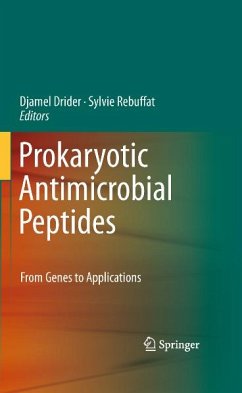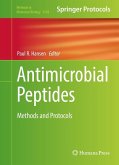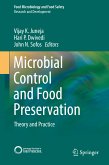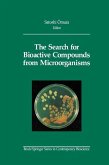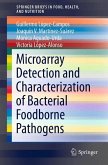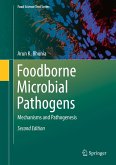Prokaryotic Antimicrobial Peptides (eBook, PDF)
From Genes to Applications
Redaktion: Drider, Djamel; Rebuffat, Sylvie


Alle Infos zum eBook verschenken

Prokaryotic Antimicrobial Peptides (eBook, PDF)
From Genes to Applications
Redaktion: Drider, Djamel; Rebuffat, Sylvie
- Format: PDF
- Merkliste
- Auf die Merkliste
- Bewerten Bewerten
- Teilen
- Produkt teilen
- Produkterinnerung
- Produkterinnerung

Hier können Sie sich einloggen

Bitte loggen Sie sich zunächst in Ihr Kundenkonto ein oder registrieren Sie sich bei bücher.de, um das eBook-Abo tolino select nutzen zu können.
The book provides an overview of the advancement of fundamental knowledge and applications of antimicrobial peptides in biomedical, agricultural, veterinary, food, and cosmetic products. Antimicrobial peptides stand as potentially great alternatives to current antibiotics, and most research in this newly-created area has been published in journals and other periodicals. It is the editors' opinion that it is timely to sum up the most important achievements in the field and provide the scientific community with a reference book. The goals of this project include illustrating the achievements…mehr
- Geräte: PC
- ohne Kopierschutz
- eBook Hilfe
- Größe: 8.13MB
![Antimicrobial Peptides (eBook, PDF) Antimicrobial Peptides (eBook, PDF)]() Antimicrobial Peptides (eBook, PDF)89,95 €
Antimicrobial Peptides (eBook, PDF)89,95 €![Cell-Penetrating Peptides (eBook, PDF) Cell-Penetrating Peptides (eBook, PDF)]() Cell-Penetrating Peptides (eBook, PDF)73,95 €
Cell-Penetrating Peptides (eBook, PDF)73,95 €![Microbial Control and Food Preservation (eBook, PDF) Microbial Control and Food Preservation (eBook, PDF)]() Microbial Control and Food Preservation (eBook, PDF)121,95 €
Microbial Control and Food Preservation (eBook, PDF)121,95 €![The Search for Bioactive Compounds from Microorganisms (eBook, PDF) The Search for Bioactive Compounds from Microorganisms (eBook, PDF)]() The Search for Bioactive Compounds from Microorganisms (eBook, PDF)161,95 €
The Search for Bioactive Compounds from Microorganisms (eBook, PDF)161,95 €![Microarray Detection and Characterization of Bacterial Foodborne Pathogens (eBook, PDF) Microarray Detection and Characterization of Bacterial Foodborne Pathogens (eBook, PDF)]() Guillermo López-CamposMicroarray Detection and Characterization of Bacterial Foodborne Pathogens (eBook, PDF)40,95 €
Guillermo López-CamposMicroarray Detection and Characterization of Bacterial Foodborne Pathogens (eBook, PDF)40,95 €![Foodborne Microbial Pathogens (eBook, PDF) Foodborne Microbial Pathogens (eBook, PDF)]() Arun K. BhuniaFoodborne Microbial Pathogens (eBook, PDF)69,95 €
Arun K. BhuniaFoodborne Microbial Pathogens (eBook, PDF)69,95 €![Regulatory Foundations for the Food Protection Professional (eBook, PDF) Regulatory Foundations for the Food Protection Professional (eBook, PDF)]() Regulatory Foundations for the Food Protection Professional (eBook, PDF)81,95 €
Regulatory Foundations for the Food Protection Professional (eBook, PDF)81,95 €-
-
-
Dieser Download kann aus rechtlichen Gründen nur mit Rechnungsadresse in A, B, BG, CY, CZ, D, DK, EW, E, FIN, F, GR, HR, H, IRL, I, LT, L, LR, M, NL, PL, P, R, S, SLO, SK ausgeliefert werden.
- Produktdetails
- Verlag: Springer New York
- Seitenzahl: 451
- Erscheinungstermin: 8. März 2011
- Englisch
- ISBN-13: 9781441976925
- Artikelnr.: 37351248
- Verlag: Springer New York
- Seitenzahl: 451
- Erscheinungstermin: 8. März 2011
- Englisch
- ISBN-13: 9781441976925
- Artikelnr.: 37351248
- Herstellerkennzeichnung Die Herstellerinformationen sind derzeit nicht verfügbar.
